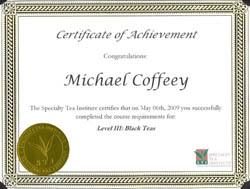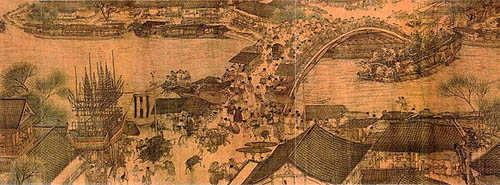 The final proof came in the mail yesterday: Â I am now certified by the Specialty Tea Institute. Â I understand that I’m the first person ever to successfully challenge levels 1 and 2, and I’ve got the black tea portion of level 3 under my belt.
The final proof came in the mail yesterday: Â I am now certified by the Specialty Tea Institute. Â I understand that I’m the first person ever to successfully challenge levels 1 and 2, and I’ve got the black tea portion of level 3 under my belt.
And I have mixed feelings about it.
On the one hand, it’s nice to have a piece of paper on the wall (albeit, with my name misspelled) certifying that I’ve completed their training. Â (And, to be honest, it’s not really on my wall.) Â At the same time, I felt it a much higher honor to have been asked by a few of my fellow students after one of the level 3 classes if they could pick my brain because, as one of them put it, “from the kinds of questions you’re asking, it seems like you know what you’re talking about.”
Also, the full STI certification program takes something like 12 days to complete all of their classes (until they add a level 4). Â Once you’ve gone through those two weeks’ worth of training, you earn America’s most well-known and respected tea certification program, with a wall’s worth of certificates. Â (There are other programs out there that promise awarding “tea master” status. Â Still others may take a bit longer but aren’t as widely recognized as STI’s program.)
But in at least China, Japan, and Taiwan, a basic training in tea is a college education. Â Two years of full time studying about tea, plus the typical general requirements, to get a Bachelor’s. Â And that’s not the advanced stuff. Â To get any kind of educational recognition, they need to learn how to grow tea and process it in a variety of ways. Â They need to be able to evaluate a tea by taste and then take the leaves back to the factory to fix flaws. Â They need to be able to identify cultivars by sight and by taste. Â They need to know how much of which kinds of fertilizer to use and how that will affect the flavor in the cup.
Here in America, though, you can get “certified” for being able to tell the difference between a black and a green tea. Â We get a certificate for making it through a couple of days of class, let alone a couple of years. Â Heck, Americans can’t even take a couple of years of tea classes if we wanted.
Unfortunately, there are lots of factors in favor of the status quo. Â A few people are willing to pay big money to get a certificate, so tea certification (especially if it’s easy, convenient, short, and expensive) is a financially viable business. Â People in the tea business can use it as a marketing tool–even though the certificate doesn’t prove skill or experience, just the ability to take a test well about recently-reviewed information.
But is that really what expertise is about? Â Is that really what we want to encourage in the world of tea?
Personally, I would prefer that the tea community collaborate with each other, and recommend each other. Â Let those who get recommended often by the peers that know them well be called the “experts”. Â Let the “tea masters” be those who have devoted decades to a particular topic within the field of tea, with the understanding that the only thing they’re a “master” in is that particular topic.
Of course, I’m not the king of human behavior, nor of economics, so I can’t make this so. Â And I’d be a little stupid not to use my certification to get me more business if I can. Â But I hope that you, dear reader, will recognize what’s possible and look beyond titles, specific classes, awards, programs, and so forth.
I hope you ask the tea people you meet what their specialties are, who they learned the most from, and what they’re currently doing to deepen their understanding in their chosen area. Â People who are truly serious about tea should be able to easily answer those questions without blinking an eye.
